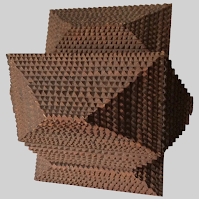In 2012 I sent to auction a collection I had built over 30 years. Texas-made furniture and stoneware, as well as paintings, quilts, and folk art. Several pieces of tramp art were part of the collection. I did a lot of buying and selling over those 30 years. My favorite tramp box was the one shown here, a cigar box piece featuring the chip or notch carving this folk art form is known by. The leather hinges worn out, crusty cocoa-colored paint, and a broadside photo image of the Skull Creek Schuetzen Verein in Shelby TX were the prominent attraction of this piece when it reached my hands in a trade in the early 1990s, all testament to its artfulness, age, history.
 |
| Another tramp piece, a wall box |
The German enclaves around Texas were known for their gun & rifle clubs—the German schuetzen verein meaning shooting club in English. Their were several in and around Houston, and my German ancestors were members.
Growing up we went to the one in the area of Cypress Texas known as the Tin Hall, officially the Cypress Gun & Rife Club. I can’t remember who, but someone told me awhile back that the Tin Hall was a meeting place for the Ku Klux Clan. If true, this tarnishes somewhat my fond memories of gatherings there—barbecues in true Texas German fashion, the dance floor upstairs, worn smooth and made better with dance floor wax powder, and the old time guitar and fiddle bands that played the songs of the really good era of country music. As a kid I learned to dance the Little Brown Jug, Put Your Little Foot, and Ten Pretty Girls with my Aunt Edna Rustenbach Fuchs. German enough for you? I think there was a little Polish in her bloodline as well.
 |
| Cypress Gun & Rife Club--the Tin Hall, 1888 |
History has it that Will Fuchs (born Wilhelm Friederich, 1869-1930), the man I would have known as Great Grandpa, though he was actually my great-great uncle, died while serving as an officer of the peace at an event held at the Spring Branch Gun & Rifle Club (Schuezten Verein) in 1930. A life-long Missouri Synod Lutheran in the tradition of his family, he was denied burial in one of the five gravesites he owned in the Trinity Lutheran Cemetery in downtown Houston because he died in a setting where alcohol was being served. Tough-minded Lutherans! The last home I owned in Houston, located at the intersection of Sandman and Rose in an old German neighborhood known as the West End, was built by Will around 1900. Will had to be buried elsewhere, of course, so his remains lie in St. Peter’s Cemetery, located in Spring Branch. And a little more history.
Spring Branch began as a religious German farmer settlement in the 1830s and became a part of the city of Houston in the 1940s-50s. In 1848, St. Peter's United (Lutheran) Church was established there.
It is the resting place not only of Will and his wife, Bertha Maria Rinkel Fuchs, but also of my grandmother, Lizzie (Elisa Christine, 1897-1983), along with her husband Frank Frederich (1897-1941), the son of Will and Bertha.
All that from a tramp art box!



No comments:
Post a Comment